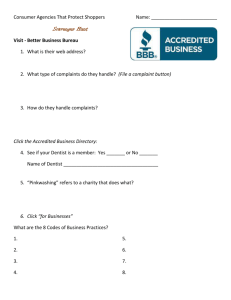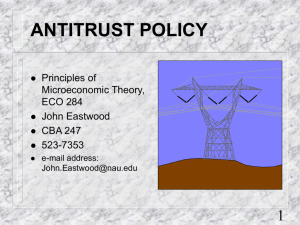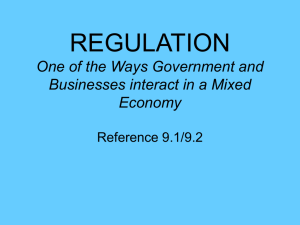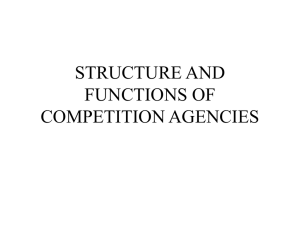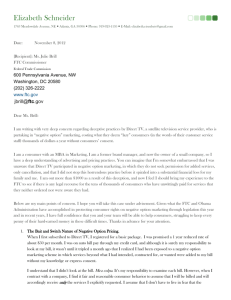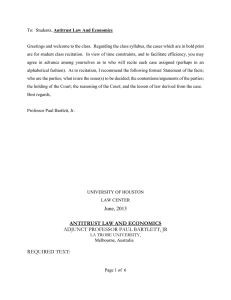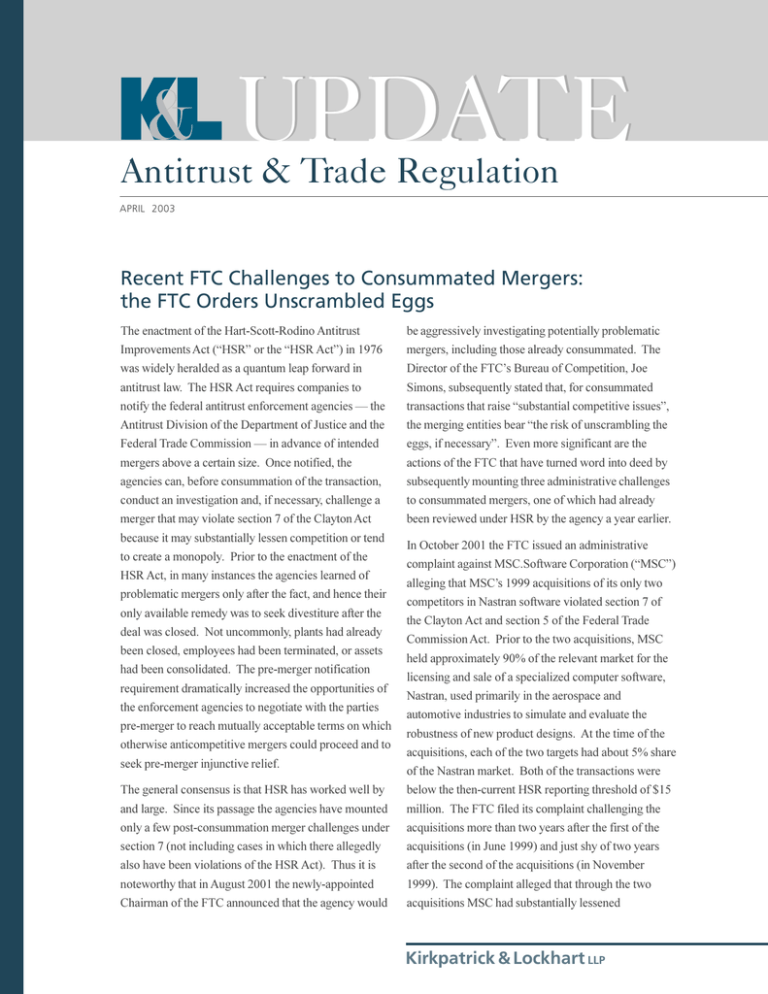
UPDATE
Antitrust & Trade Regulation
APRIL 2003
Recent FTC Challenges to Consummated Mergers:
the FTC Orders Unscrambled Eggs
The enactment of the Hart-Scott-Rodino Antitrust
Improvements Act (HSR or the HSR Act) in 1976
was widely heralded as a quantum leap forward in
antitrust law. The HSR Act requires companies to
notify the federal antitrust enforcement agencies the
Antitrust Division of the Department of Justice and the
Federal Trade Commission in advance of intended
mergers above a certain size. Once notified, the
agencies can, before consummation of the transaction,
conduct an investigation and, if necessary, challenge a
merger that may violate section 7 of the Clayton Act
because it may substantially lessen competition or tend
to create a monopoly. Prior to the enactment of the
HSR Act, in many instances the agencies learned of
problematic mergers only after the fact, and hence their
only available remedy was to seek divestiture after the
deal was closed. Not uncommonly, plants had already
been closed, employees had been terminated, or assets
had been consolidated. The pre-merger notification
requirement dramatically increased the opportunities of
the enforcement agencies to negotiate with the parties
pre-merger to reach mutually acceptable terms on which
otherwise anticompetitive mergers could proceed and to
seek pre-merger injunctive relief.
The general consensus is that HSR has worked well by
and large. Since its passage the agencies have mounted
only a few post-consummation merger challenges under
section 7 (not including cases in which there allegedly
also have been violations of the HSR Act). Thus it is
noteworthy that in August 2001 the newly-appointed
Chairman of the FTC announced that the agency would
be aggressively investigating potentially problematic
mergers, including those already consummated. The
Director of the FTCs Bureau of Competition, Joe
Simons, subsequently stated that, for consummated
transactions that raise substantial competitive issues,
the merging entities bear the risk of unscrambling the
eggs, if necessary. Even more significant are the
actions of the FTC that have turned word into deed by
subsequently mounting three administrative challenges
to consummated mergers, one of which had already
been reviewed under HSR by the agency a year earlier.
In October 2001 the FTC issued an administrative
complaint against MSC.Software Corporation (MSC)
alleging that MSCs 1999 acquisitions of its only two
competitors in Nastran software violated section 7 of
the Clayton Act and section 5 of the Federal Trade
Commission Act. Prior to the two acquisitions, MSC
held approximately 90% of the relevant market for the
licensing and sale of a specialized computer software,
Nastran, used primarily in the aerospace and
automotive industries to simulate and evaluate the
robustness of new product designs. At the time of the
acquisitions, each of the two targets had about 5% share
of the Nastran market. Both of the transactions were
below the then-current HSR reporting threshold of $15
million. The FTC filed its complaint challenging the
acquisitions more than two years after the first of the
acquisitions (in June 1999) and just shy of two years
after the second of the acquisitions (in November
1999). The complaint alleged that through the two
acquisitions MSC had substantially lessened
Kirkpatrick & Lockhart LLP
competition and had engaged in monopolization and
attempted monopolization. Entry into the market
allegedly was difficult, the acquisitions made a highly
concentrated market even more concentrated, and the
acquisitions prevented other suppliers from acquiring
either of the two companies acquired by MSC and
thereby increasing market competition.
The relief sought by the complaint was the creation and
divestiture of up to two viable and independent
competitors of MSC in the market for the sale and
licensing of Nastran. To this end, the FTC sought, inter
alia, that MSC:
n
n
n
n
n
n
divest all software, intellectual property, and other
assets for the operation of such competitors;
facilitate the competitors recruitment of its
employees;
provide the newly created competitors with certain
customer lists and account information;
allow customers to terminate or rescind contracts or
license agreements in order to deal with the newly
created competitors;
furnish technical assistance to the competitors; and
maintain an open architecture for Nastran for a
defined period of time so that customers could
switch between MSC and the newly created
competitors.
In August of last year the FTC announced that it had
reached a settlement with MSC. The settlement
provided, inter alia, that MSC must divest not only the
software products it acquired, but also at least one clone
copy of its own then-current Nastran software,
including the source code, through royalty-free,
perpetual, nonexclusive licenses to one or two acquirers
who will be approved by the FTC. The settlement also
included much of the ancillary relief sought by the FTC
in its complaint. A divestiture proposal is still pending
before the FTC.
In commenting on the settlement, Joe Simons, the
Director of the Commissions Bureau of Competition,
stated, [c]ompanies that scramble the eggs may be
2
required to divest not only the assets acquired but also
additional assets that may be needed to restore the lost
competition. Patrick Roach, the Deputy Assistant
Director in the Anticompetitive Practices Division in
the FTCs Bureau of Competition, is reported to have
said of the MSC challenge, We thought it was
important to remind people that the Hart-Scott threshold
is not an antitrust exemption. Even when youre below
the threshold, the antitrust laws still apply.
Shortly after filing the MSC challenge, the FTC filed an
administrative complaint challenging the February 2001
acquisition by Chicago Bridge & Iron Company, N.V.
of two divisions of Pitt-Des Moines, Inc. The
complaint alleges that the acquisition was
anticompetitive because it significantly reduced
competition in four separate markets involving the
design and construction of various types of field-erected
specialty industrial storage tanks in the United States.
Most significantly, the FTC seeks to unwind the
transaction even though the parties had complied with
the HSR requirements. The FTC reportedly missed the
deadline to make a formal second request for
information and, although Chicago Bridge postponed
the closing for more than three months to allow the
agency additional time to review the deal, the agency
did not challenge the deal before the closing. The
parties closed in early February 2001, with the FTCs
administrative challenge coming eight months later.
The remedies sought in the agencys complaint include
rescission of the acquisition and reestablishment by
Chicago Bridge of two distinct and viable competing
businesses in each of the four relevant markets,
including through divestiture, replacement and
reconstitution by [Chicago Bridge], of all assets,
tangible and intangible, including intellectual property,
customer contracts, and personnel, as are necessary or
useful in restoring viable competition in the lines of
commerce alleged. Closing arguments in the twomonth trial before an administrative law judge were
presented in January of this year. As of this writing no
decision has yet been rendered.
If the FTC is successful before the administrative law
judge and through the appeals process, it would be the
KIRKPATRICK & LOCKHART LLP ANTITRUST & TRADE REGULATION UPDATE
first time the FTC has unwound a consummated merger
that one of the federal antitrust agencies subjected to
HSR review but did not challenge before closing.
While it is beyond dispute that the HSR Act does not
expressly create antitrust immunity, it has been the case
for more than twenty-five years that surviving HSR
review has allowed the parties to close their deal with
some confidence that there is no substantial risk of
subsequent agency challenge. That confidence would
appear to be less well-placed in view of Chicago
Bridge, whatever the outcome of the litigation.
Finally, also in October 2001, the FTC entered into a
settlement with Airgas, Inc. that resolved the agencys
charges that Airgas $90 million purchase (more than 22
months earlier) of the Puritan Bennett Medical Gas
Business from Mallinckrodt, Inc. had an adverse effect
on competition in the domestic market for nitrous oxide
in violation of section 7 of the Clayton Act and section
5 of the FTC Act. The administrative complaint alleged
that before the acquisition Airgas and Puritan Bennett
were direct competitors in the domestic market for
nitrous oxide and that the acquisition effectively
eliminated all competition for the production and sale
of nitrous oxide. In order to restore competition to the
market, the consent order requires Airgas to divest to
Air Liquide America Corporation a nitrous oxide
business, including a production plant in Pennsylvania
and one in California, customer contracts, and all
related assets necessary for distribution and storage.
The FTCs post-consummation challenges to these three
mergers were followed by its announcement last
August of the formation of a Merger Litigation Task
Force whose mission includes, according to the
Commissions press release, reinvigorating the
Commissions hospital merger program, which includes
a review of, and potential challenges to, consummated
transactions that may have resulted in anticompetitive
price increases. The Task Force has also been directed
to focus on merger enforcement in the retail industry,
particularly matters involving food, beverages, and
supermarkets. Two months later, Tenet Healthcare
announced that the FTC was investigating its 1999
acquisition of two hospitals in Poplar Bluff, Missouri.
APRIL 2003
Because the FTC has committed the resources to this
area, it is reasonable to expect future FTC challenges to
consummated mergers.
A post-consummation enforcement action filed in
January of this year by the Department of Justice is also
worth mentioning in this context. The DOJs
Complaint, filed in the Northern District of Ohio,
alleged that reciprocal sales of certain assets used in the
publication of alternative newsweeklies in Cleveland,
Ohio and Los Angeles, California constituted a market
allocation scheme between Village Voice Media, LLC
and NT Media LLC. The parties had announced and
consummated this deal in early October 2002. Even
though the transaction was challenged under section 1
of the Sherman Act as a conspiracy in restraint of trade
rather than as a merger implicating section 7 of the
Clayton Act, the theory of the challenge was similar,
alleging that the transaction allowed the parties to
obtain monopolies in the two affected markets.
Prior to October 1, 2002, Village Voice and NT Media
competed vigorously in the alternative newsweekly
markets in Los Angeles and Cleveland. After the
companies unsuccessful attempts to merge and to
acquire each others Cleveland newsweeklies, in
October 2002 they entered into two interlocking
agreements whereby New Times would close its Los
Angeles publication and Village Voice would close its
Cleveland publication and pay New Times the net
amount of $9 million. The parties also agreed to
transfer to each other their accounts receivable,
customer lists, and advertising contracts in the affected
markets, but not other assets, such as trademarks,
employee contracts, and the like. The interlocking
agreements effectively gave New Times a monopoly in
the Cleveland market and the Village Voice a monopoly
in the Los Angeles market. The DOJ challenged these
agreements to swap markets under section 1 of the
Sherman Act more than three months after the parties
had closed their respective Cleveland and Los Angeles
operations and transferred assets to each other.
In its proposed consent decree, the Department, inter
alia, seeks the complete divestiture by each party of its
assets in the two closed newsweeklies (including
Kirkpatrick & Lockhart LLP
customer lists and advertising contracts) to new entrants
in the affected markets, prohibits the companies from
entering into market or customer allocation agreements
in the future, allows advertisers to terminate contracts
entered into with the surviving paper after the shutdown of its rival, and renders void all noncompete
agreements with former employees in the affected
markets. It has been reported that the two companies
also would pay $610,000 in civil penalties and
$140,000 in attorneys fees to the State of California
and smaller amounts to the State of Ohio. Coterminous
with the Departments filing of its Complaint, the
parties announced that they had agreed to the proposed
consent decree. The sixty-day comment period has
expired and, as of this writing, the decree is awaiting
court approval.
there is no applicable statute of limitations for
agency challenges under section 7 of the Clayton
Act; while the passage of time may provide some
comfort to the surviving entity, it should not create
an illusion of immunity for mergers or acquisitions
that are deemed by one of the enforcement agencies
to be sufficiently problematic, especially since the
general rule is that laches cannot be asserted as a
defense against the federal government;
n
the post-consummation divestiture remedy is a
powerful tool whose use is not limited to merger
challenges under section 7 of the Clayton Act; and
n
as a condition of settlement of problematic mergers
or acquisitions, the current policy of the FTC is to
require, in most cases, a purchaser for the divested
assets that has been approved by the FTC; the FTC
is requiring divestiture to entities in which it has a
high level of confidence that they will be viable
competitors so that the settlement will work as
planned.
n
The FTCs challenges to consummated mergers and
acquisitions and the DOJs post-consummation action
against the Village Voice and New Times confirm some
old maxims of antitrust law and practice and teach a
few new ones as well:
n
n
surviving agency review, without challenge, under
the HSR Act does not create antitrust immunity from
post-consummation challenge; while such challenges
are still the exception, the FTC has indicated clearly
that they are not aberrations and may become more
frequent;
failing to meet the now-current $50 million size-ofthe-transaction threshold which triggers the
notification requirement under HSR also does not
create antitrust immunity; indeed, the fact that the
three challenged mergers discussed above were all
relatively small suggests an agency strategy to
scrutinize and challenge small transactions more
aggressively than recently has been the agencys
practice;
JAMES E SCHEUERMANN
jscheuermann@kl.com
412.355.6215
K&Ls Antitrust and Trade Regulation practice provides
comprehensive antitrust counseling to clients on achieving
business objectives while complying with the antitrust laws.
If you have any questions regarding the subject matter discussed
in this Alert, please contact one of the following attorneys:
James E. Scheuermann 412.355.6215 jscheuermann@kl.com
Thomas A. Donovan
412.355.6466 tdonovan@kl.com
Kirkpatrick & Lockhart LLP
Challenge us.
BOSTON
n
DALLAS
n
HARRISBURG
n
LOS ANGELES
n
MIAMI
n
NEWARK
n
NEW YORK
n
PITTSBURGH
n
SAN FRANCISCO
n
WASHINGTON
.........................................................................................................................................................
This publication/newsletter is for informational purposes and does not contain or convey legal advice. The information herein
should not be used or relied upon in regard to any particular facts or circumstances without first consulting with a lawyer.
© 2003 KIRKPATRICK & LOCKHART LLP.
ALL RIGHTS RESERVED.


